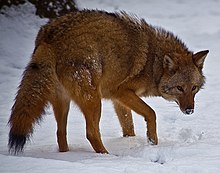Eastern coyote: Difference between revisions
m WP:CHECKWIKI error fixes, removed stub tag using AWB (9241) |
m Chrisrus moved page Canis latrans "var." to Eastern "Coyote": WP:COMMONNAME, http://www.bioone.org/doi/abs/10.1656/045.017.0202 |
(No difference)
| |
Revision as of 15:22, 9 June 2013
| Eastern coyote | |
|---|---|

| |
| Eastern coyote in West Virginia. | |
| Scientific classification | |
| Kingdom: | |
| Phylum: | |
| Class: | |
| Infraclass: | |
| Order: | |
| Family: | |
| Genus: | |
| Species: | C. latrans
|
| Subspecies: | C. l. "var."
|
| Trinomial name | |
| Canis latrans "var." Lawrence and Bossert, 1969[1]
| |
The Eastern coyote (Canis latrans "var."), also known as the New England canid or tweed wolf, is a wild canid of mixed grey wolf-coyote parentage present in New England, New York, New Jersey, Pennsylvania, Ontario, Quebec, Nova Scotia,[2] and New Brunswick.[3] It was first noticed during the 1930s and 40s, and likely originated in the aftermath of the extermination of grey wolves in the northeast, thus allowing coyotes to colonize former eastern grey wolf ranges and mix with the remnant grey wolf populations.[4] A close relative to them are the Eastern wolves, who are also hybrid canids of mixed grey wolves and coyote descents but with a higher grey wolf percentage than the eastern coyotes. While both of these animals are genetically coywolves, the Eastern wolves are considered wolves due to them having backcrossed extensively with parent grey wolf populations while the eastern coyotes are the results of backcrossing with the pure western coyotes.[5] This hybrid is smaller than the pure grey wolf, and holds smaller territories, but is in turn larger and holds more extensive home ranges than the typical western pure coyote. Hybridization between the two species was facilitated by the close relationship between coyotes and grey wolves, both of which are found in North America, although unlike the coyote the grey wolf is of Eurasian origin. As of 2010, the eastern coyote's genetic makeup is fairly uniform, with minimal influence from grey wolves or western coyotes.[4]
Description

Adult eastern coyotes are larger than western coyotes, weighing an average of 30-40 lbs, with female eastern coyotes weighing 21% more than male western coyotes.[4][6] Eastern coyotes also weigh more at birth; while newborn western coyotes weigh 250-300 grams, eastern coyotes weigh 349-360 grams. By the age of 35 days, eastern coyote pups average 1590 grams, 200 grams more than western coyotes of similar age. By this time, physical differences become more apparent, with eastern coyote pups having longer legs than their western counterparts. Differences in dental development also occur, with tooth eruption being later, and in a different order in the eastern coyote.[7] Aside from its size, the eastern coyote is physically not unlike the western coyote; both have erect ears, a straight and bushy tail, a conspicuous supracaudal gland and a narrow chest. There are four color phases, ranging from dark brown to blond or reddish blond, though the most common phase is gray-brown, with reddish legs, ears and flanks.[8] There are no significant differences between eastern and western coyotes in expressing aggression and fighting, though eastern coyotes tend to fight less, and are more playful. Unlike western coyote pups, in which fighting precedes play behavior, fighting among eastern coyote pups occurs after the onset of play.[7] Eastern coyotes tend to reach sexual maturity when they reach two years of age, much later than in western coyotes.[4]
Gallery
References
- ^ Lawrence, B. & Bossert, W. H. (1969). The cranial evidence for hybridization in New England Canis. Breviora 330, 1–13.
- ^ [1],Frequently Asked Questions about Eastern Coyote in Nova Scotia, Government of Nova Scotia
- ^ [2], Living with Wildlife Eastern coyotes, Government of New Brunswick
- ^ a b c d Way, J.G., L. Rutledge, T. Wheeldon, B.N. White. 2010. Genetic characterization of Eastern “Coyotes” in eastern Massachusetts. Northeastern Naturalist. 17(2): 189-204.
- ^ Attention: This template ({{cite pmid}}) is deprecated. To cite the publication identified by PMID 21566151, please use {{cite journal}} with
|pmid=21566151instead. - ^ Way, J. G. 2007. A comparison of body mass of Canis latrans (Coyotes) between eastern and western North America. Northeastern Naturalist 14(1): 111–24.
- ^ a b Bekoff, M. 1978. Behavioral Development in Coyotes and Eastern Coyotes. In: M. Bekoff, (ed.), Coyotes: Biology, Behavior, and Management: 97-124. Academic Press, New York
- ^ Hilton, Henry. 1978. Systematics and Ecology of the Eastern Coyote. In: M. Bekoff, (ed.), Coyotes: Biology, Behavior, and Management: 210-28. Academic Press, New York
Further reading
- Parker, G.E. 1995. Eastern coyote: the story of its success. Nimbus, Halifax, Nova Scotia, Canada.
- Way, J. G. 2007. Suburban Howls: Tracking the Eastern Coyote in Urban Massachusetts. Dog Ear Publishing, Indianapolis, Indiana, USA.



